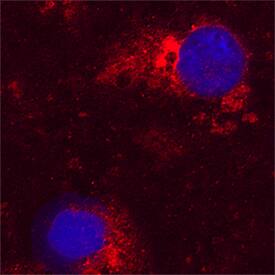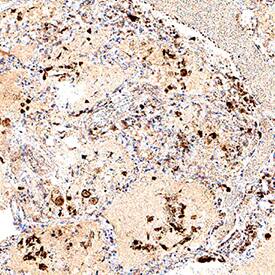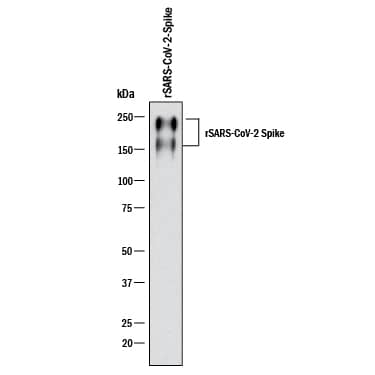SARS-CoV-2 Spike S2 Subunit Antibody
R&D Systems, part of Bio-Techne | Catalog # MAB108891
Recombinant Monoclonal Antibody.

Key Product Details
Species Reactivity
SARS-CoV-2
Applications
Immunocytochemistry, Immunohistochemistry, Western Blot
Label
Unconjugated
Antibody Source
Recombinant Monoclonal Rabbit IgG Clone # 2824E
Product Specifications
Immunogen
Chinese Hamster Ovary cell line, CHO-derived human SARS-CoV-2 Spike protein
Met1-Lys1211
Accession # YP_009724390.1
Met1-Lys1211
Accession # YP_009724390.1
Specificity
Detects human SARS-CoV-2 spike S2 in direct ELISAs and Western Blot
Clonality
Monoclonal
Host
Rabbit
Isotype
IgG
Scientific Data Images for SARS-CoV-2 Spike S2 Subunit Antibody
Detection of SARS-CoV-2 Spike Protein by Western Blot.
Western blot shows recombinant SARS-CoV-2 spike protein. PVDF membrane was probed with 1 µg/mL of Rabbit Anti-SARS-CoV-2 Spike S2 Subunit Monoclonal Antibody (Catalog # MAB108891) followed by HRP-conjugated Anti-Rabbit IgG Secondary Antibody (HAF008). A specific band was detected for the Spike Protein at approximately 150-250 kDa (as indicated). This experiment was conducted under reducing conditions and using Western Blot Buffer Group 1.Spike S2 Subunit in HEK293 Human Cell Line.
Spike S2 Subunit was detected in immersion fixed HEK293 human embryonic kidney cell line transfected using Rabbit Anti-SARS-CoV-2 Spike S2 Subunit Monoclonal Antibody (Catalog # MAB108891) at 3 µg/mL for 3 hours at room temperature. Cells were stained using the NorthernLights™ 557-conjugated Anti-Rabbit IgG Secondary Antibody (red; NL004) and counterstained with DAPI (blue). Specific staining was localized to cytoplasm. Staining was performed using our protocol for Fluorescent ICC Staining of Non-adherent Cells.Spike S2 Subunit in SARS-CoV-2 infected human lung.
Spike S2 Subunit was detected in immersion fixed paraffin-embedded sections of SARS-CoV-2 infected human lung using Rabbit Anti-SARS-CoV-2 Spike S2 Subunit Monoclonal Antibody (Catalog # MAB108891) at 3 µg/mL for 1 hour at room temperature followed by incubation with the Anti-Rabbit IgG VisUCyte™ HRP Polymer Antibody (VC003). Before incubation with the primary antibody, tissue was subjected to heat-induced epitope retrieval using Antigen Retrieval Reagent-Basic (CTS013). Tissue was stained using DAB (brown) and counterstained with hematoxylin (blue). Specific staining was localized to immunoreactive profiles scattered throughout the tissue. Staining was performed using our protocol for IHC Staining with VisUCyte HRP Polymer Detection Reagents.Applications for SARS-CoV-2 Spike S2 Subunit Antibody
Application
Recommended Usage
Immunocytochemistry
3-25 µg/mL
Sample: Immersion fixed HEK293 human embryonic kidney cell line transfected
Sample: Immersion fixed HEK293 human embryonic kidney cell line transfected
Immunohistochemistry
3-25 µg/mL
Sample: Immersion fixed paraffin-embedded sections of SARS-CoV-2 infected human lung
Sample: Immersion fixed paraffin-embedded sections of SARS-CoV-2 infected human lung
Western Blot
1 µg/mL
Sample: Recombinant SARS-CoV-2 spike protein
Sample: Recombinant SARS-CoV-2 spike protein
Formulation, Preparation, and Storage
Purification
Protein A or G purified from cell culture supernatant
Reconstitution
Reconstitute at 0.5 mg/mL in sterile PBS. For liquid material, refer to CoA for concentration.
Formulation
Lyophilized from a 0.2 μm filtered solution in PBS with Trehalose. *Small pack size (SP) is supplied as a 0.2 µm filtered solution in PBS.
Shipping
Lyophilized product is shipped at ambient temperature. Liquid small pack size (-SP) is shipped with polar packs. Upon receipt, store immediately at the temperature recommended below.
Stability & Storage
Use a manual defrost freezer and avoid repeated freeze-thaw cycles.
- 12 months from date of receipt, -20 to -70 °C as supplied.
- 1 month, 2 to 8 °C under sterile conditions after reconstitution.
- 6 months, -20 to -70 °C under sterile conditions after reconstitution.
Background: Spike S2 Subunit
References
- Wu, F. et al. (2020) Nature 579:265.
- Tortorici, M.A. and D. Veesler (2019). Adv. Virus Res. 105:93.
- Bosch, B.J. et al. (2003) J. Virol. 77:8801.
- Belouzard, S. et al. (2009) Proc. Natl. Acad. Sci. 106:5871.
- Millet, J.K. and G. R. Whittaker (2015) Virus Res. 202:120.
- Yuan, Y. et al. (2017) Nat. Commun. 8:15092.
- Walls, A.C. et al. (2010) Cell 180:281.
- Jiang, S. et al. (2020) Trends. Immunol. https://doi.org/10.1016/j.it.2020.03.007.
- Ortega, J.T. et al. (2020) EXCLI J. 19:410.
- Wrapp, D. et al. (2020) Science 367:1260.
- Tai, W. et al. (2020) Cell. Mol. Immunol. https://doi.org/10.1016/j.it.2020.03.007.
- Okba, N. M. A. et al. (2020). Emerg. Infect. Dis. https://doi.org/10.3201/eid2607.200841.
- Wang, X. et al. (2020) https://doi.org/10.1038/s41423-020-0424-9.
- Wang, K. et al. (2020) bioRxiv https://www.biorxiv.org/content/10.1101/2020.03.14.988345v1.
Long Name
Spike Protein, S2 Subunit
Alternate Names
COVID-19, S2 protein, SARS-CoV-2, SARS-CoV-2 Spike, Spike glycoprotein Subunit 2, spike protein, Spike protein S2, structural protein, surface glycoprotein
UniProt
Additional Spike S2 Subunit Products
Product Documents for SARS-CoV-2 Spike S2 Subunit Antibody
Product Specific Notices for SARS-CoV-2 Spike S2 Subunit Antibody
For research use only
